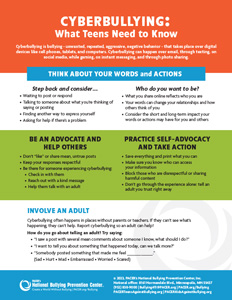In This Section
Cyberbullying: What Teens Need to Know
Cyberbullying is bullying – unwanted, repeated, aggressive, negative behavior – that takes place over digital devices like cell phones, tablets, and computers. Cyberbullying can happen over email, through texting, on social media, while gaming, on instant messaging, and through photo sharing.
Think About Your Words and Actions
Step back and consider:
- Waiting to post or respond
- Talking to someone about what you’re thinking of saying or posting
- Finding another way to express yourself
- Asking for help if there’s a problem
Who do you want to be?
- What you share online reflects who you are
- Your words can change your relationships and how others think of you
- Consider the short and long-term impact your words or actions may have for you and others
Be An Advocate and Help Others
- Don’t “like” or share mean, untrue posts
- Keep your responses respectful
- Be there for someone experiencing cyberbullying:
- Check in with them
- Reach out with a kind message
- Help them talk with an adult
Practice Self-Advocacy and Take Action
- Save everything and print what you can
- Make sure you know who can access your information
- Block those who are disrespectful or sharing harmful content
- Don’t go through the experience alone: tell an adult you trust right away
Involve An Adult
Cyberbullying often happens in places without parents or teachers. If they can’t see what’s happening, they can’t help. Report cyberbullying so an adult can help!
How do you go about telling an adult? Try saying:
- “I saw a post with several mean comments about someone I know, what should I do?”
- “I want to tell you about something that happened today, can we talk more?”
- “Somebody posted something that made me feel ___________. (Sad, hurt, mad, embarrassed, worried, scared, etc.)”
